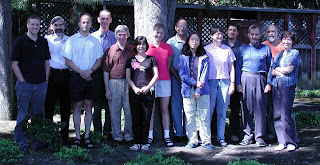Mathematicians Could Map E8 Lie Group
 14 Team members of the Atlas Project (photo courtesy: American Institute of Mathematics)
14 Team members of the Atlas Project (photo courtesy: American Institute of Mathematics)The American Institute of Mathematics (AIM) announced today that after four years of intensive collaboration, 18 top mathematicians and computer scientists from the U.S. and Europe have successfully mapped E8, one of the largest and most complicated structures in mathematics.
This achievement is significant both as an advance in basic knowledge and because of the many connections between E8 and other areas, including string theory and advanced geometry, number theory and chemistry.
 Sophus Lie
Sophus Lie E8 is an example of a Lie group. Lie groups were invented by the 19th century Norwegian mathematician Sophus Lie to study symmetry. Underlying any symmetrical object, such as a sphere, is a Lie group. Balls, cylinders or cones are familiar examples of symmetric three-dimensional objects. Mathematicians study symmetries in higher dimensions and this has applications in many conceptual issues in various branches of science. E8 is an extraordinarily complicated group: it is the symmetries of a particular 57-dimensional object, and E8 itself is 248-dimensional!
The magnitude of the E8 calculation invites comparison with the Human Genome Project. The human genome, which contains all the genetic information of a cell, is less than a gigabyte in size. The result of the E8 calculation, which contains all the information about E8 and its representations, is 60 gigabytes in size. That is enough space to store 45 days of continuous music in MP3 format. The answer, if written out in tiny print, would cover an area the size of Manhattan.
The E8 calculation is part of an ambitious project known as the Atlas of Lie Groups and Representations. The goal of the Atlas project is to determine the unitary representations of all the Lie groups. This is one of the great unsolved problems of mathematics, dating from the early 20th century. The Atlas team consists of about 20 researchers from the United States and Europe. The core group consists of Jeffrey Adams (University of Maryland), Dan Barbasch (Cornell), John Stembridge (University of Michigan), Peter Trapa (University of Utah) , Marc van Leeuwen (Poitiers, France), David Vogan (MIT), and (until his death in 2006) Fokko du Cloux (Lyon, France).


1 Comments:
A bit more complicated than my own symmetry work then...:)
Post a Comment
<< Home